- Week 1 : Project Management
- Week 2 : Computer-aided
- Week 3 : Computer Controlled Cutting
- Week 4 : Embedded Programming
- Week 5 :3D Scanning and Printing
- Week 6 : Electronic Design
- Week 7 : Computer Controlled Machining
- Week 8 : Electronics Production
- Week 9 : Input Devices
- Week 10 : Output Devices
- Week 11 : Networking and Communication
- Week 12 : Mechanical Design and Machine Design
- Week 13 : Midterm Review
- Week 14 : Molding and Casting
- Week 15 : Interface and Application Programming
- Week 16 : System Integeration
- Week 17 : Wildcard Week
- Week 18 : Applications and Implications, Project Development
- Week 19 : Invention, Intellectual property and Income
- Week 20 : FInal Project Requirements
Week 14 : Molding and Casting
Objectives of the Week
- Linked to the group assignment page and reflected on your individual page what you have learned
- Reviewed the safety data sheets for each of your molding and casting materials, then made and compared test casts with each of them
- Documented how you designed and created your 3D mold, including machine settings
- Ensured your mold has smooth surface finish, that does not show the production process
- Shown how you safely made your mold and cast the parts
- Described problems and how you fixed them
- Included your design files and 'hero shot' of the mold and the final object
Group Assignment Contribution
For More about Group Assignment
Reviewing the data sheets
1. Silicone Rubber (e.g., OOMOO, Dragon Skin)
Silicone rubbers are widely used for flexible molds. They are generally safe but can cause mild skin and eye irritation during mixing. Most formulations are platinum-cured or tin-cured and are two-part systems.
Hazards
Low toxicity, but some components may cause irritation on contact. Vapors are usually minimal but should still be avoided in confined areas.
Handling
Wear nitrile gloves to prevent direct contact. Safety glasses should be used when mixing or pouring. Avoid breathing vapors and always work in a ventilated space.
Storage
Keep containers tightly closed when not in use. Store at room temperature, away from direct sunlight and moisture.
First Aid
In case of skin contact, wash thoroughly with soap and water. If it contacts the eyes, flush immediately with water for several minutes. Seek medical help if irritation persists.
2. Polyurethane Resin (e.g., Smooth-Cast Series)
Polyurethane resins are popular for hard casting. They typically come in Part A and Part B components that chemically react to form rigid plastics. Isocyanates in Part A are a significant health concern.
Hazards
Can cause serious skin and eye irritation. Vapors may irritate the respiratory system. Sensitization is possible with repeated exposure.
Handling
Use nitrile gloves, chemical splash goggles, and work in a fume hood or well-ventilated area. Avoid any contact with skin and do not inhale vapors.
Storage
Store in tightly sealed containers. Moisture-sensitive—exposure to humidity can ruin the material or cause dangerous reactions.
First Aid
Seek immediate medical attention if inhaled. If skin contact occurs, wash immediately with soap and warm water. Rinse eyes thoroughly if exposed.
3. Epoxy Resin (e.g., West System, ArtResin)
Epoxy resins are two-part thermosetting polymers used for clear casting and coatings. Though common, they require careful handling to avoid long-term sensitization and allergic reactions.
Hazards
Skin sensitizer and moderate irritant. Inhalation of vapors can cause headaches or nausea. Repeated exposure may lead to allergies or dermatitis.
Handling
Always wear gloves (preferably nitrile), safety goggles, and ensure you have proper airflow. Use a respirator if working with large volumes or poor ventilation.
Storage
Store both parts in original containers, tightly sealed, in a cool, dry location. Avoid contamination between Part A and Part B.
First Aid
Wash exposed skin with soap and water immediately. If epoxy contacts eyes, rinse for 15 minutes with clean water. Seek medical attention if irritation or allergic symptoms occur.
4. Alginate (e.g., Dental Grade or Life Casting Alginate)
Alginate is a natural material derived from seaweed, often used for body part molding due to its skin safety. It is mixed with water and cures quickly to form flexible molds.
Hazards
Generally non-toxic and safe for skin. Inhalation of fine powder may cause irritation to the respiratory system. Not recommended for use around open wounds.
Handling
Wear a dust mask while mixing dry alginate to avoid inhaling particles. Gloves are optional unless sensitive skin is involved. Avoid spilling powder on wet surfaces, as it can become slippery.
Storage
Keep dry and sealed in an airtight container. Exposure to moisture can ruin the powder or shorten its shelf life.
First Aid
If inhaled, move to fresh air and rinse mouth. If in eyes, flush gently with water. If irritation occurs on skin, rinse with warm water and stop use.
5. General Safety Guidelines
- Always read the full Safety Data Sheet (SDS) before use.
- Wear Personal Protective Equipment (PPE): gloves, goggles, mask/respirator as needed.
- Ensure good ventilation or use fume extraction systems.
- Label materials and store safely away from food, flames, or sunlight.
- Dispose of uncured materials as hazardous waste per local regulations.
Individual Assignment
Now Let's jump into the Individual Assignment
Molding and Casting
Molding and casting are powerful manufacturing techniques used to duplicate objects by first creating a mold of the desired shape and then filling it with a casting material. This process is essential in both prototyping and production, offering the ability to replicate intricate geometries with high precision, repeatability, and efficiency across a variety of materials.
Types of Molding and Casting
Various types of molding and casting methods exist, each tailored to specific materials, applications, and production volumes. Below is a breakdown of some of the most widely adopted techniques, categorized into molding and casting processes.
Types of Molding
Compression Molding
This method involves placing a preheated material—typically a thermoset plastic—into a heated mold cavity. The mold is then closed and pressure is applied to shape the material. It is frequently used for manufacturing automotive parts, electrical insulators, and durable kitchenware.
- Advantages: Minimal material waste, ideal for large-sized components
- Disadvantages: Slower cycle time, not suitable for intricate details
Injection Molding
Molten plastic is injected under high pressure into a mold cavity to form complex shapes quickly and accurately. It is the most common method used for producing plastic products like packaging, toys, and electronic housings.
- Advantages: High-speed production, excellent accuracy, scalable for mass manufacturing
- Disadvantages: High cost of tooling and setup
Blow Molding
This process is primarily used to create hollow plastic parts such as bottles. A heated plastic preform is inflated inside a mold until it conforms to the cavity’s shape.
- Advantages: Fast production, perfect for hollow shapes
- Disadvantages: Only suitable for hollow items, limited shape complexity
Rotational Molding
Plastic powder is placed inside a mold that is rotated on multiple axes while being heated. The powder melts and evenly coats the inner surfaces of the mold, forming a hollow object.
- Advantages: Even wall thickness, cost-effective molds
- Disadvantages: Long cycle time, not ideal for small, detailed parts
Types of Casting
Sand Casting
This traditional process involves pouring molten metal into a mold made of compacted sand. After the metal solidifies, the sand mold is broken to extract the final product.
- Advantages: Inexpensive, suitable for producing large or bulky components
- Disadvantages: Coarse surface texture, less dimensional precision
Investment Casting (Lost Wax)
A wax model is created and coated with a ceramic shell. Once the shell hardens, the wax is melted out, and molten metal is poured in. Ideal for fine, detailed metal parts.
- Advantages: Exceptional accuracy and surface finish
- Disadvantages: Expensive, labor-intensive, slower process
Die Casting
This method uses high-pressure injection of molten metal into steel molds. Commonly used for high-volume production of parts made from aluminum, zinc, and magnesium.
- Advantages: High dimensional accuracy, very fast cycle times
- Disadvantages: High tooling cost, suitable only for non-ferrous metals
Plaster Casting
Similar to sand casting but utilizes a plaster-based mold for better surface finish and detail. Best for non-ferrous metals and low-volume production.
- Advantages: Fine detail reproduction, smooth surface finish
- Disadvantages: Fragile molds, only for low-melting-point metals
Mold Design
In the initial stage of mold design, we begin by constructing a basic geometric form in SolidWorks. The foundation starts with a 2D sketch of a circle with a diameter of 50 mm. This dimension is used as the base size for a series of concentric features that gradually build up the complexity of the mold. This approach allows for precision control over thickness and depth, which is critical when creating molds for casting.
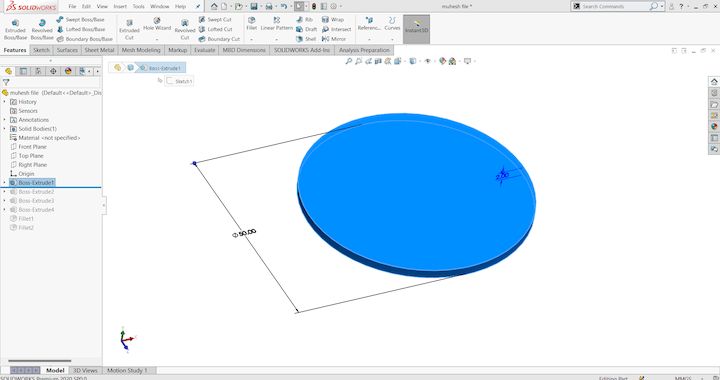
Stage 1: We create a base circular sketch of 50 mm diameter. This sketch will serve as the primary profile on which further design layers will be built. It represents the outermost edge of the mold geometry.
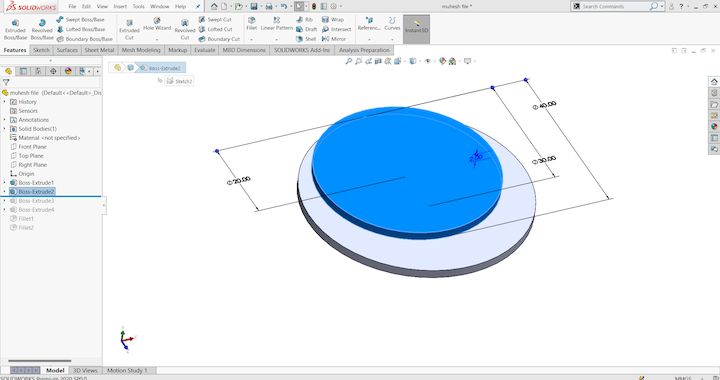
Stage 2: An inner concentric circle is added inside the base sketch to create a stepped feature. This step marks the beginning of layering and adds a second level of surface that will influence the casting shape when poured.
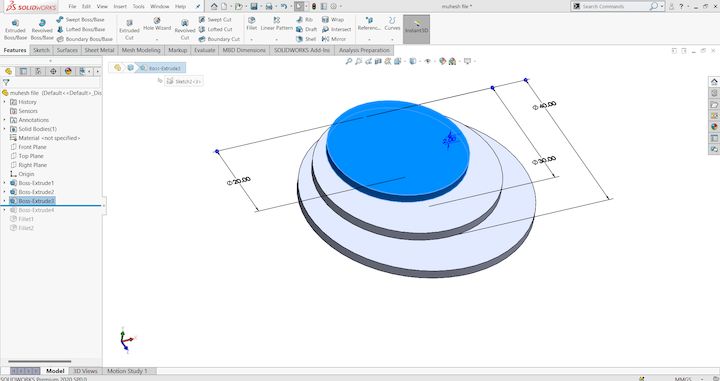
Stage 3: Additional concentric sketches are created inside the second layer, continuing the stepped pattern. These intermediate circular boundaries allow us to design distinct zones that will later be extruded to different heights, giving depth to the mold's internal cavities.
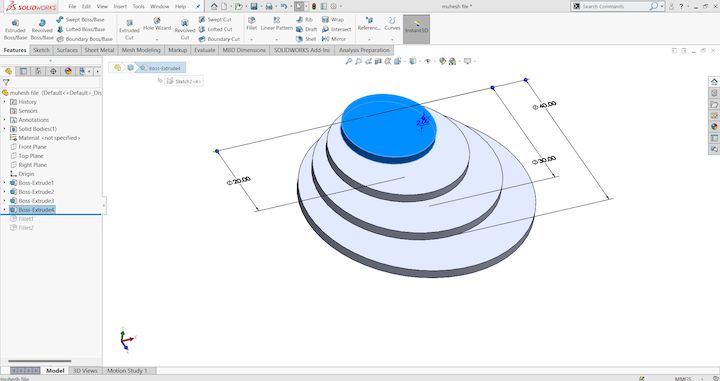
Stage 4: Each of the concentric profiles is extruded to form a stepped 3D structure. The heights are carefully assigned to define mold contours and capture fine details that would appear in the final casted product. This extruded solid is now fully ready for the transition into CAM.
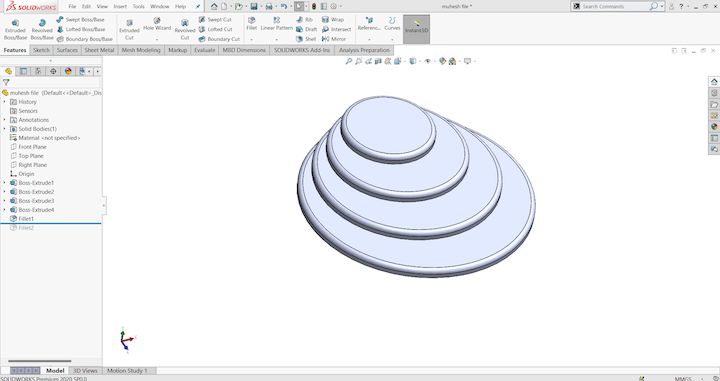
Stage 5: The model is reviewed in isometric view to verify accuracy and dimensional integrity. This ensures the design meets both aesthetic and functional requirements before proceeding further. It also allows for error detection before exporting the file for toolpath generation.
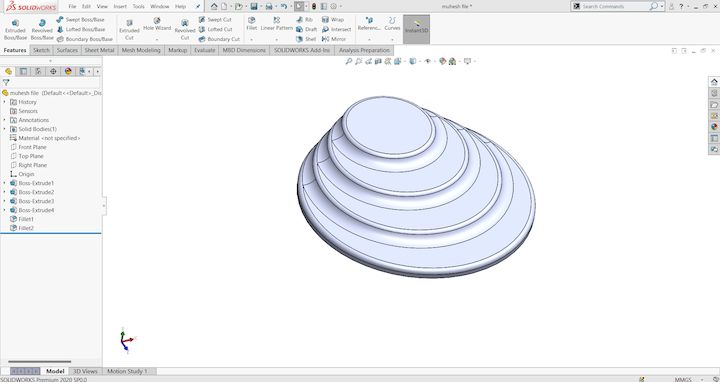
CAM Toolpath Generation in ArtCAM
Once the 3D model is finalized in SolidWorks, the next step is to generate CNC-compatible toolpaths in ArtCAM. This software enables us to create a precise machining strategy, converting our 3D geometry into instructions the milling machine can follow. ArtCAM is especially useful in mold-making due to its visual interface and robust toolpath simulation capabilities. The following stages demonstrate how the model is processed for machining.
Stage 1: The SolidWorks model is imported into ArtCAM. We begin by defining the size of the material block that matches or exceeds the dimensions of the 3D model. Proper placement of the model within this material block ensures all features can be milled without overcuts.
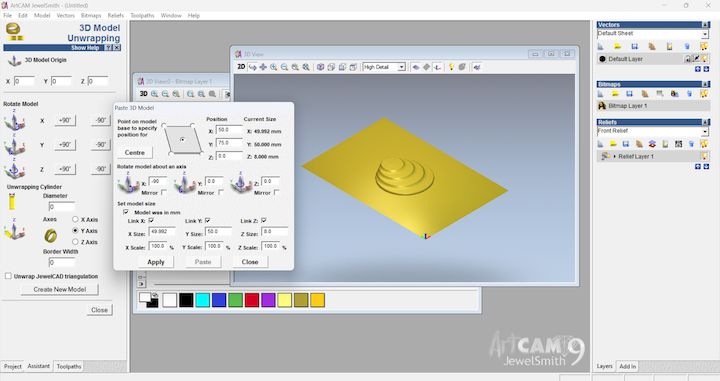
Stage 2: We establish the Z-zero position and machining boundaries. This setup is essential to instruct the CNC machine where to begin cutting and how deep to go. The alignment of the workpiece on the bed and the tooling origin are defined here.
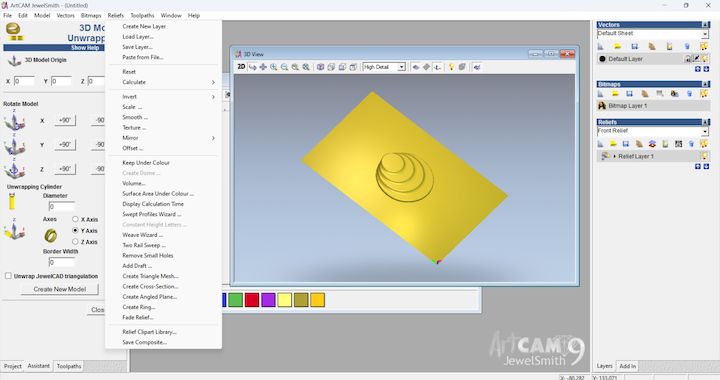
Stage 3: A roughing toolpath is generated using a larger end mill. This step removes the bulk of the material quickly, following a safe margin from the actual design to avoid damaging detailed areas. Parameters like step-down depth and tool overlap are carefully adjusted.
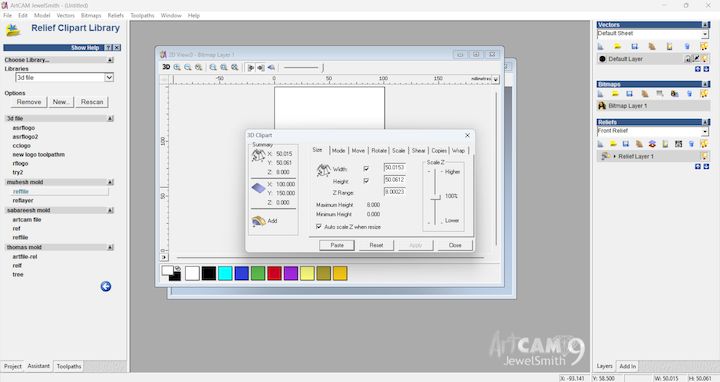
Stage 4: Once roughing is done, a finishing toolpath is created with a smaller tool, such as a ball-end mill. This toolpath follows the precise contour of the mold, ensuring that all intricate details and curved surfaces are milled with high accuracy.
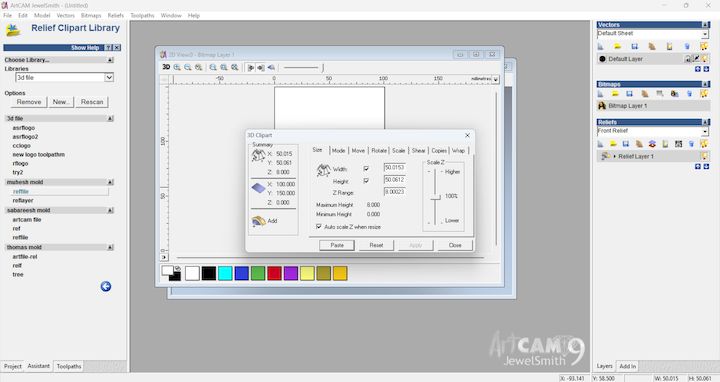
Stage 5: A simulation is run to visualize how the tool interacts with the material. This simulation is essential to preview the final finish and to spot any tool collisions or incomplete areas before committing to real machining. Adjustments are made based on this output.
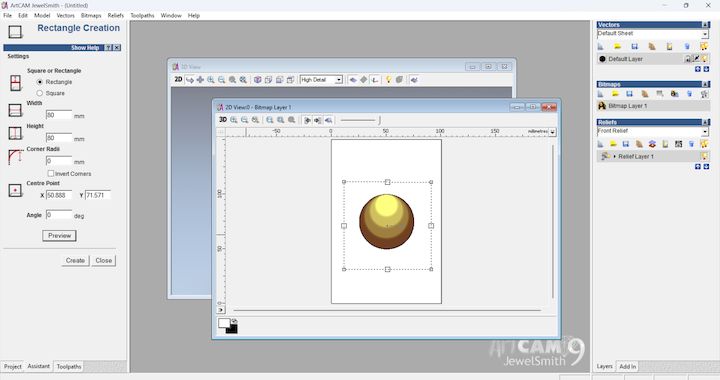
Stage 6: A close-up view of the finishing simulation shows the precise ridges and depth transitions of the design. This stage validates the quality of surface finish and confirms that the machining strategy captures the fidelity of the original SolidWorks model.
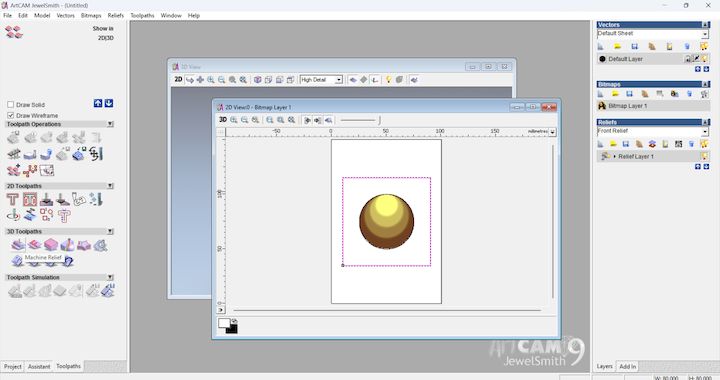
Stage 7: Depth visualization is applied to the toolpaths, showcasing Z-axis movement. This allows better understanding of the cutting profile and ensures that each layer is milled progressively without overloading the tool.
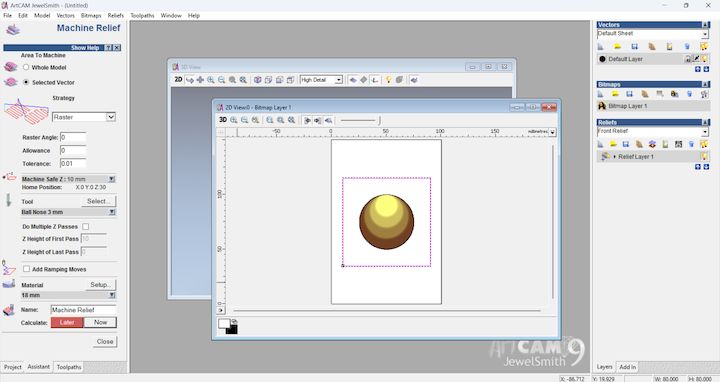
Stage 8: Final validation of toolpaths and selection of post-processor format compatible with your CNC machine (e.g., GRBL, Mach3). ArtCAM then generates the G-code, which is the instruction set that guides the CNC router to execute the mold carving process.
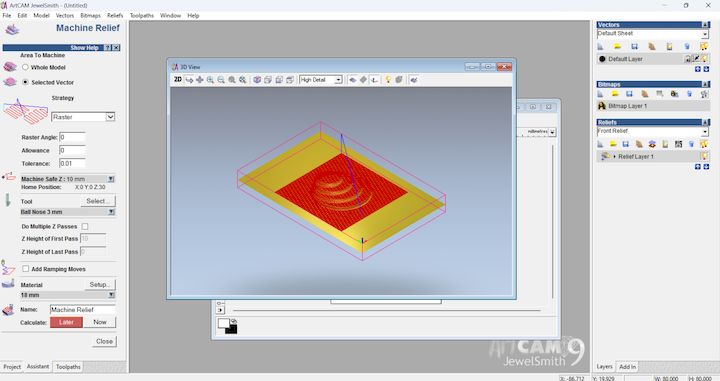
Stage 9: Toolpaths are exported, and the setup is now ready for physical machining. The result will be a precision-cut mold cavity, made from the CAD model and refined through CAM simulations, ready for casting processes like silicone, resin, or wax pouring.
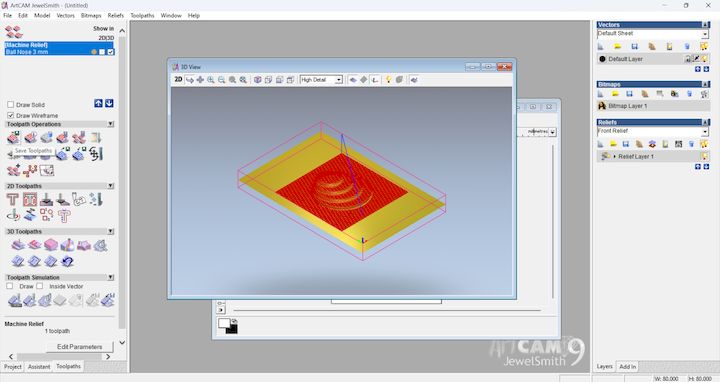
Introduction
In the initial stages of mold fabrication, we opted to use CNC milling to create a precise mold. However, the process encountered a critical setback. During the milling operation, the tool bit fractured due to an excessive depth of cut. This tool failure not only delayed the timeline but also posed a risk of material wastage. To address this issue efficiently and continue progress, we decided to pivot from CNC milling to 3D printing for mold fabrication.
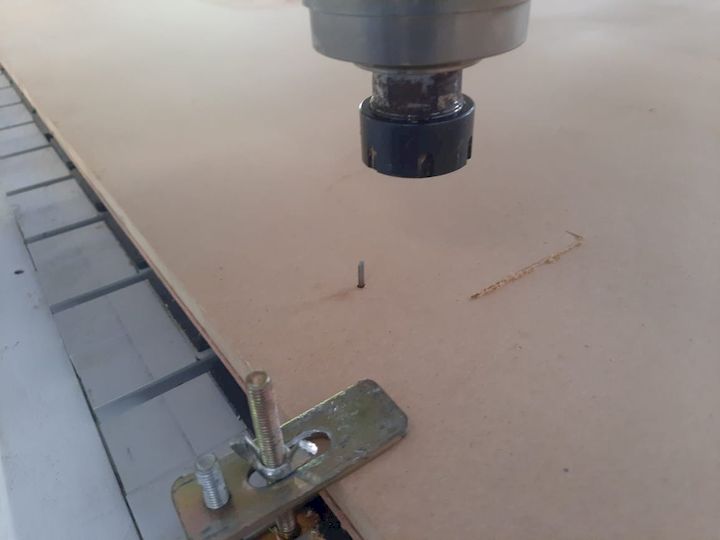
Switch to 3D Printing Method
The decision to switch to 3D printing was strategic. 3D printing provided a quicker alternative with a high degree of detail and accuracy. It also offered the benefit of avoiding further material wastage or equipment damage. Using PLA as the material of choice, we initiated the 3D printing process by first preparing the model.
The STL file was exported from SolidWorks and imported into slicing software. Print settings were carefully optimized to ensure a high-quality finish. One critical setting was the layer height, which was adjusted to 0.1 mm. This fine resolution setting played a crucial role in capturing intricate surface details of the mold, ensuring that the final printed object met precision and quality expectations.
The 3D printing process concluded successfully, resulting in a mold that faithfully reproduced the design intent. The printed mold had a smooth surface and detailed contours, thanks to the optimized settings, particularly the layer height.
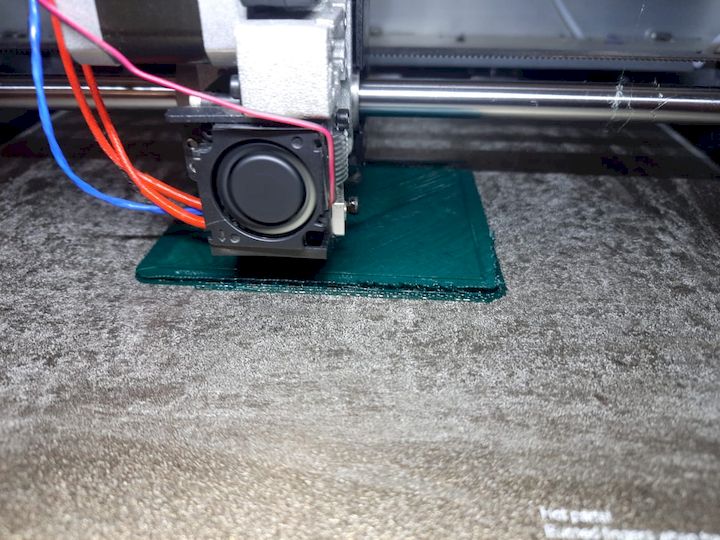
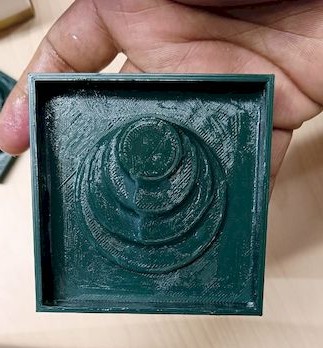
Preparation for Silicone Mold Casting
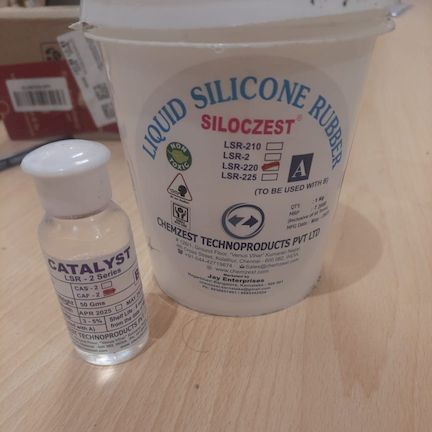
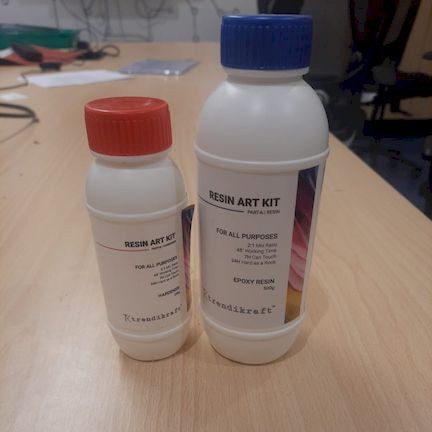
Before proceeding to cast silicone into the 3D printed mold, it was essential to estimate the required volume of silicone. Accurate measurement was vital to avoid material shortage or wastage.
To calculate the needed silicone volume, we filled the 3D printed cavity with water. This method allowed us to determine the mold's internal volume precisely. The water was then poured into a 250 ml measuring beaker to record the total volume.
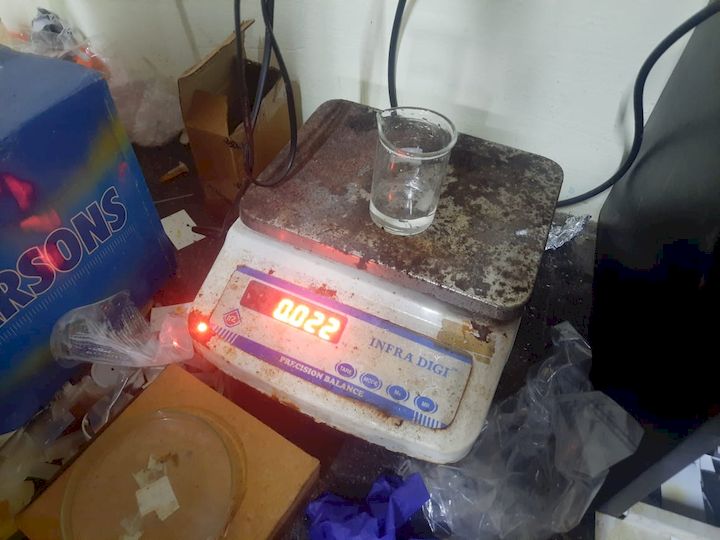
Prior to pouring the water, we tared the beaker by recording its empty weight. This ensured that the final volume measurement excluded the beaker's weight, giving a true representation of the mold's internal capacity.
Using the recorded volume, we turned to an online silicone mold calculator to determine the appropriate quantities of silicone base and catalyst. The calculator helped derive the exact ratio and amounts for each component, ensuring the final mix would cure properly and produce a durable, bubble-free mold.
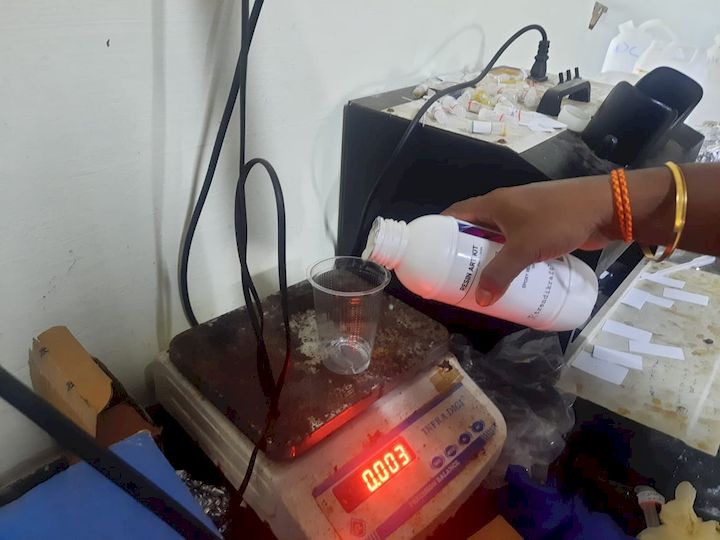
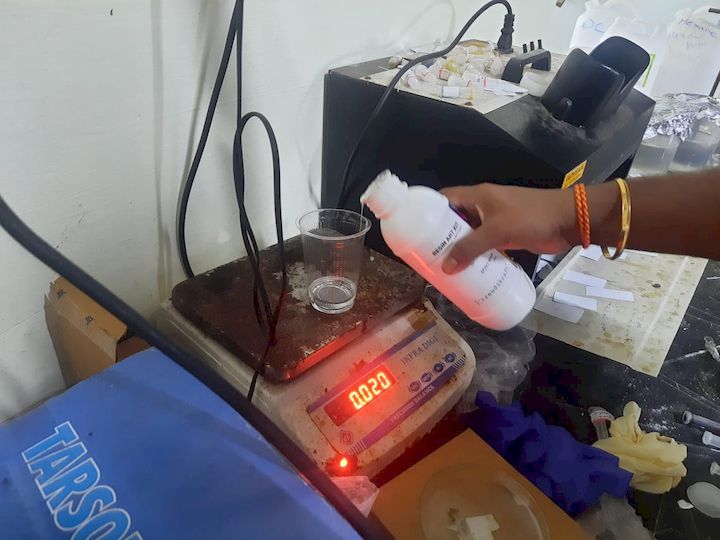
Silicone Mixing Process
Equipped with protective gloves for safety, we began the silicone mixing process. The silicone base was poured into a clean plastic beaker. Once the base was added, we tared the beaker again to zero out the scale. This allowed us to measure the catalyst separately and accurately.
According to the calculated ratio, we added 2 grams of catalyst to the silicone base. Precision in this step is critical, as incorrect measurements can lead to curing failures or weak molds. The mixture was then stirred thoroughly to ensure an even distribution of catalyst throughout the base. Mixing was done slowly to minimize air bubble formation.
After the mixture was homogenous, it was left to settle briefly. This allowed any air bubbles that may have formed during stirring to rise to the surface and escape, reducing defects in the final mold.
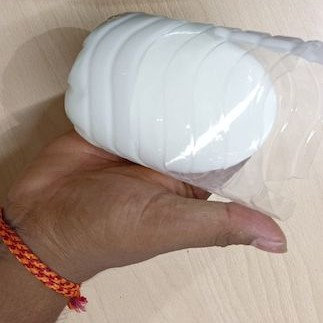
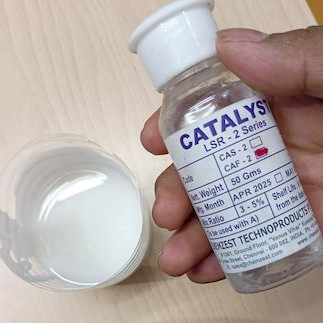
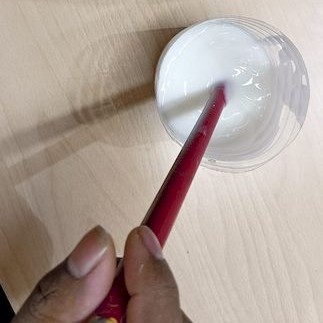
Pouring the Silicone into the Mold
Before pouring, we applied a release agent inside the 3D printed mold cavity to prevent the silicone from bonding to the PLA surface. This would aid in easy demolding after curing.
The mixed silicone was then poured slowly into the mold cavity. Care was taken to pour from one corner, allowing the material to flow naturally and fill the mold uniformly. This technique also helped in pushing out any trapped air and ensured that fine details within the mold were filled accurately.
Curing and Demolding
The mold was left to cure undisturbed for the recommended time, as specified by the silicone manufacturer. After the curing period, the silicone had solidified well and conformed precisely to the shape of the mold cavity. The surface was smooth, and all design features were captured effectively.
The resulting negative mold was robust, clean, and ready for use in casting materials such as chocolate or resin.
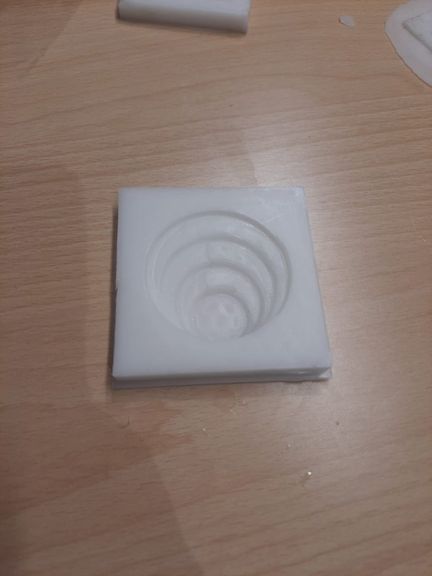
Preparation for Resin Casting
To cast resin into the silicone mold, we needed another round of precise measurement. Again, the 250 ml beaker was tared to ensure that only the resin's weight would be recorded.
Resin casting involved a two-part mixture using a 2:1 ratio of Part A (resin) to Part B (hardener). After measuring the required amount of Part A, we calculated and measured half that volume of Part B.
Accurate measurement is critical in resin casting. Any deviation from the ratio can result in incomplete curing, stickiness, or structural weakness. With careful weighing and verification, we ensured the proper amounts of both components.
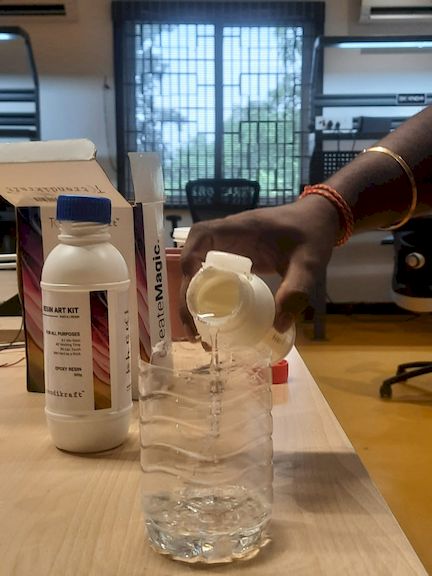
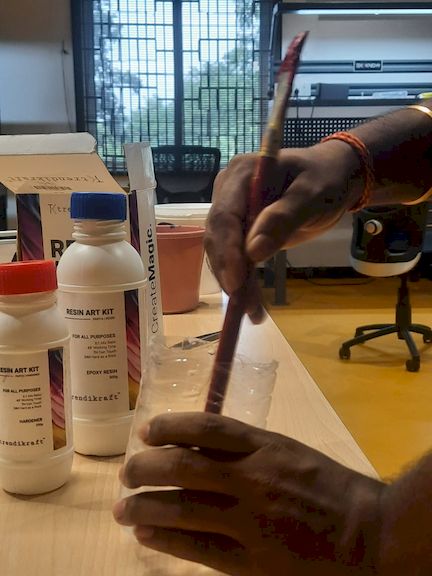
Resin Mixing and Pouring
Once both components were measured, they were combined and mixed thoroughly. Mixing was done slowly and carefully to avoid introducing air bubbles. The mixed resin was then allowed to sit momentarily, letting any trapped air rise to the surface.
The mixed resin was poured into the silicone mold, starting from one side to allow a natural flow. This helped the resin fill every detail and reduced the chances of air pockets being trapped inside.
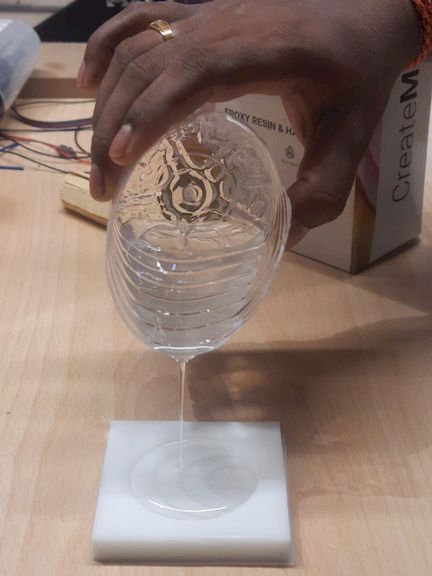
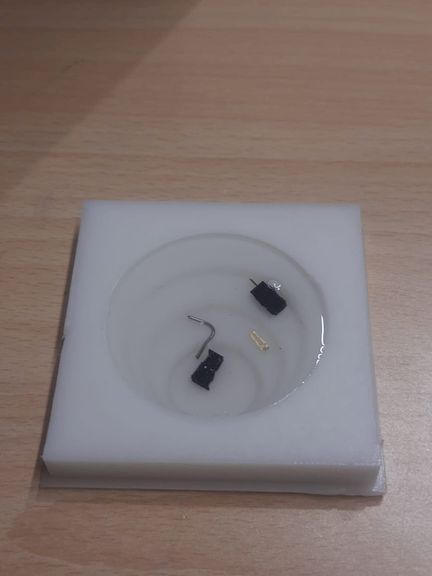
Resin Curing and Final Output
After the mold was filled, it was left to cure for the specified duration. The curing process was done undisturbed to ensure optimal strength and clarity in the final cast.
Once cured, the cast part was carefully demolded. The final product reflected a high-quality finish, with smooth surfaces and well-defined details, validating the effectiveness of the entire molding and casting process.
Conclusion
Despite the initial setback due to CNC tool failure, the project adapted efficiently by transitioning to 3D printing for mold fabrication. The use of precise measurement techniques, careful mixing, and attention to detail in the casting process led to the successful creation of both a high-quality silicone mold and a resin-cast final product. This experience underlined the importance of flexibility and accuracy in fabrication workflows.